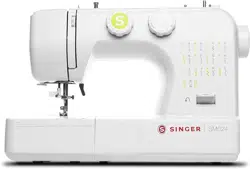Loading ...
Loading ...
Loading ...

KNOWING YOUR SEWING MACHINE
10
Needle, thread and fabric chart
Your fabric will determine the choice of a needle and thread. The following table is a practical guide to needle and thread
selection.
Always refer to it before a new sewing project. And be sure to use the same size and type of thread in the bobbin as in the top
thread supply.
Kind Fabric Threads Needle size
Light
Weight
Voile, Organza, Organdy,
Chiffon, Tricot
Fine Silk,
Fine Cotton,
Fine Polyester
9 or 12
Medium
Weight
Linen, Cotton,
Rayon, Wool
Double Knit
Cotton, Polyester,
All-Purpose
12 or 14
Heavy
Weight
Denim, Tweed, Gaba
rdine,
Canvas, Upholstery Fabric
Polyester, All-Purpose,
Topstitching
14 or16
CAUTION
Always disconnect the machine from power supply by removing the
plug from the wall-outlet.
Changing the needle
1. Raise the needle by turning hand wheel toward you and
lower the presser foot.
2. Rotate the needle clamp screw toward you (counter-
clockwise) to loosen the needle.
3. Remove the needle from the clamp.
4. Insert the new needle into the needle clamp with the flat
side away from you.
5. When inserting the needle into the clamp, push it up as far
as it will go.
6. Tighten the clamp screw clockwise firmly with the
screwdriver.
* Check your needles frequently for barbed or
blunted points.
Snags and runs in knits, fine silks and silk-like
fabrics are permanent and are almost always caused
by damaged needle.
NOTE: Tighten snugly, but do not over tighten.
Helpful Hint: Placing a scrap of fabric under the presser foot and
lowering the presser foot makes it easier to change the needle and will
preclude dropping the needle into the needle plate slot.
Change the needle often. As a general rule,
needles, should be changed every 6-8 hours of
actual stitching time.
Loading ...
Loading ...
Loading ...
